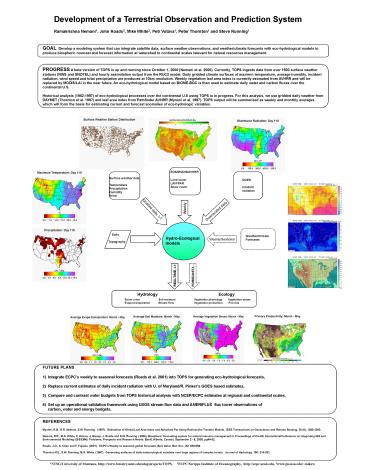Primary Productivity: March May PowerPoint PPT Presentation
Title: Primary Productivity: March May
1
PROGRESS A beta version of TOPS is up and running
since October 1, 2000 (Nemani et al. 2000).
Currently, TOPS ingests data from over 1500
surface weather stations (NWS and SNOTEL) and
hourly assimilation output from the RUC2 model.
Daily gridded climate surfaces of max/min
temperature, average humidity, incident
radiation, wind speed and total precipitation are
produced at 10km resolution. Weekly vegetation
leaf area index is currently estimated from AVHRR
and will be replaced by MODIS/LAI in the near
future. An eco-hydrological model based on
BIOME-BGC is then used to estimate daily water
and carbon fluxes over the continental
U.S. Historical analysis (1982-1997) of
eco-hydrological processes over the continental
U.S using TOPS is in progress. For this analysis,
we use gridded daily weather from DAYMET
(Thornton et al. 1997) and leaf area index from
Pathfinder AVHRR (Myneni et al. 1997). TOPS
output will be summerized as weekly and monthly
averages which will form the basis for estimating
current and forecast anomalies of eco-hydrologic
variables.
EOS/MODIS/AVHRR Land cover LAI/FPAR Snow cover
Surface weather data Temperature Precipitation H
umidity Wind
Gridded daily, t-1
Downscaled daily
Soils Topography
Hydro-Ecological models
Weekly/Seasonal
REALTIME, t-1
FORECAST,t...
Hydrology
Ecology
Snow cover Soil
moisture Evapo-transpiration Stream
flow
Vegetation phenology Vegetation
stress Vegetation production Fire risk
Primary Productivity March - May
FUTURE PLANS 1) Integrate ECPCs weekly to
seasonal forecasts (Roads et al. 2001) into TOPS
for generating eco-hydrological forecasts, 2)
Replace current estimates of daily incident
radiation with U. of Maryland/R. Pinkers GOES
based estimates, 3) Compare and contrast water
budgets from TOPS historical analysis with
NCEP/ECPC estimates at regional and continental
scales, 4) Set up an operational validation
framework using USGS stream flow data and
AMERIFLUX flux tower observations of
carbon, water and energy budgets.
PowerShow.com is a leading presentation sharing website. It has millions of presentations already uploaded and available with 1,000s more being uploaded by its users every day. Whatever your area of interest, here you’ll be able to find and view presentations you’ll love and possibly download. And, best of all, it is completely free and easy to use.
You might even have a presentation you’d like to share with others. If so, just upload it to PowerShow.com. We’ll convert it to an HTML5 slideshow that includes all the media types you’ve already added: audio, video, music, pictures, animations and transition effects. Then you can share it with your target audience as well as PowerShow.com’s millions of monthly visitors. And, again, it’s all free.
About the Developers
PowerShow.com is brought to you by CrystalGraphics, the award-winning developer and market-leading publisher of rich-media enhancement products for presentations. Our product offerings include millions of PowerPoint templates, diagrams, animated 3D characters and more.

